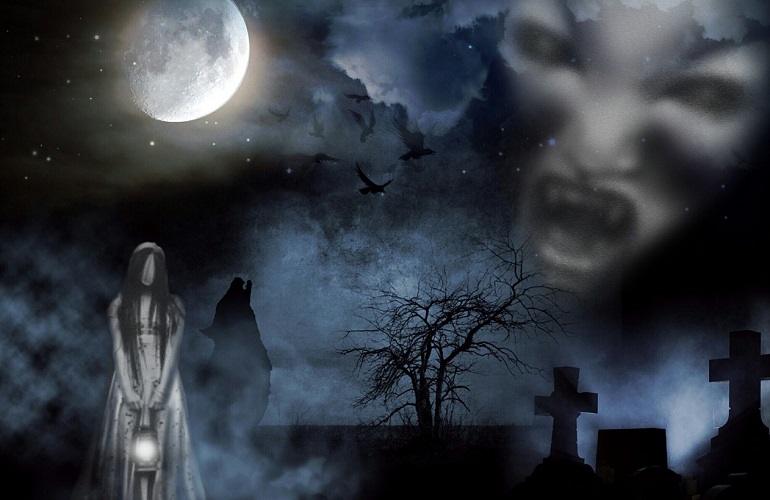Back in May, I shared some of my thoughts on design. These were mostly just some of my design philosophies for implementing new rules at the table. I thought today we’d revisit that topic and walk through some House Rules for more horror like settings I’m using now and considering for the future. It is October after all.
Purgatory Rules
In my current campaign, the PCs are already dead. No, I didn’t TPK the party, the premise is they are all petitioners in the city of Purgatory. The PCs had full lives, loves, enemies and unfinished business. Since I wanted the player character’s to have histories and experiences more advanced than your typical level one PC they were allowed to start at 5th level. But, you can’t take it with you…Each PC started with significantly less starting money than a typical 5th level PC. This allows me to use weaker monsters and still have them threaten the party. Which is particularly useful since the plan is for this to be a limited campaign maybe six months of play and every treasure will also feel like advancement.
We’re not really using any special rules for the dead because in Purgatory all the petitioners are basically starting over. The big house rules here involve additional states of the dead. Once a PC or NPC petitioner dies again they lay dormant for a random period of time before rising again as shambled. Shambled mindless undead mechanically little different from zombies. Not the zombies of film, however, they have no hunger for flesh and are mostly docile at least for a while. Eventually, though the constant excruciating pain of their mortal injuries drives many of the shambled to frenzy and lash out. Roving packs of feral shambled lurk beyond the walls of Purgatory. This is the fate that most likely awaits every resident of Purgatory. Unless they avoid serious injury or are killed with an oblivion weapon. A petitioner killed by an oblivion weapon is utterly destroyed (on a failed save) and fades away.
House Rules for Harrowing Combat
(Not that kind of Harrow, put the cards away)
I really want to run a fast-paced rules light and spooky Halloween one-shot and so I need to figure out what rules changes will best suit my goals for the game. So first I want to identify a problem I think we need to solve, I don’t want to change rules I don’t have to.
For the horror vibe, I’m looking for, Pathfinder is too heroic. So I have a couple of ideas to tone it down and make it a bit grittier. First up, let’s look at the d20 itself. The 3era Dungeons and Dragons release Unearthed Arcana proposed using 3d6 instead of a d20 to make all the rolls. It takes reduces some of the random chance and makes the character’s abilities a little more relevant to success or failure. For good and ill extremely lucky becomes a little more uncommon.
One change I’d make to the UA: 3d6 rule would be to borrow something from the Pathfinder Playtest. Instead of using the Critical results as they are modified in Unearthed Arcana I’m just going to make critical successes happen on “18’s” and if the roll is 5 points above the target DC. This does mess with weapons with expanded threat ranges so I’ll let those weapons critical if the roll is 4 points above the target DC. I won’t allow qualities to stack beyond lowering that number to a 3.
Combat should be scary and fast-paced. I’m looking at reducing the number of dice rolls at the table. With the luck behind criticals reduced I’m going to do away with confirmation rolls. I think I’ll also do away with damage rolls. All weapons will inflict maximum damage + plus the appropriate ability modifier. Criticals will inflict bonus damage equal to half the weapon’s normal damage (without the modifier) for every 5 points (or fewer for increased threat ranges) over the Target DC.
Because I’m using static weapon damage, I want a way to mitigate some of it, so we’ll use the Armor as Damage reduction rules from Ultimate Combat or Unearthed Arcana. I’ll need to give the two systems a very close look in relation to the other rules I have here.
We’ll set HP at max hit die -2 because I want the characters to be a little more fragile but not too much so.
While we’re looking at health and injury rules let’s pause at death and dying. There are aspects I like of the current PF1 rules (particularly how easy it is to determine your condition) but I also like that dying in the Playtest is separate from negative HP. For this game, I’d like to hybrid the two concepts and illustrate how dangerous such serious injuries can be. This rule won’t work in every game but for a gritty action or horror campaign, I think it will function well.
When a character reaches 0 hp they begin dying. They lose no more hit points but suffer 1 point of Constitution Bleed each round. If they reach zero Constitution they are Dead. A dying PC may make a DC 10 Constitution check (as normal) to stabilize. The stabilize cantrip prevents the target from losing any more points of Con bleed as a result of reaching 0 hp it has no effect on any other Con bleed. I this way Constitution damage may be a sign of lasting injuries such as cracked ribs and deep bruises.
One thing I’m really enjoying in the Playtest is the mobility in the game. Characters don’t just stand toe to toe and slug it out a huge chunk of that is the reduced number of Attacks of Opportunity. I have a house rule I’m thinking about that would allow fighters to take one AoO automatically and then stipulate when certain other classes could take one. But that’s a separate discussion, for this game I’m going to experiment with removing them entirely unless the character has Combat Reflexes. A character with that feat may then take one AoO each round.
Another way the Playtest shines on the subject of mobility is how the action economy allows characters to move about. Without porting over the full 3 actions a round rule (which can be done pretty easily) we can instead remove the feats Spring Attack and Shot on the Run from the game and simply allow all characters and creatures to move – attack – move. I think mobility is important especially in horror because players need to feel like they can at least attempt flee from an opponent that is too strong.
So what are some horror house rules you use at the table?







